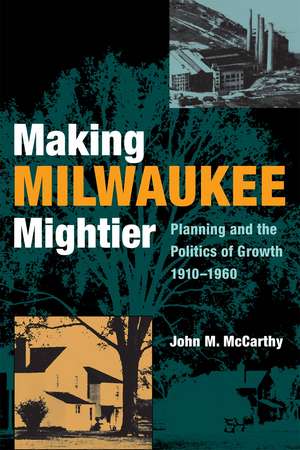Making Milwaukee Mightier: Planning and the Politics of Growth, 1910-1960
Autor John M. McCarthyen Limba Engleză Hardback – 8 mar 2009
Progressive Era city planners are best known for grandiose civic designs, boosterish planning reports, and promoting technical exper-tise. Traditionally, Milwaukee has not been considered a national standout in these early endeavors; however, the planners in this city are distinctive precisely because they prioritized solving the social problem of overcrowding in lieu of more conventional planning goals. Another unique characteristic of this period is the long tenure of socialist city government. McCarthy offers fresh new insights into socialism’s impact on Milwaukee, studying the planning and growth policies of all three of the city’s socialist mayors and finding striking continuity in the movement’s metropolitan visions.
While most of its Midwest counterparts saw their urban boundaries frozen, Milwaukee grew dramatically during this crucial era in American urban history. Its growth, however, drew the ire of increasingly hostile suburban neighbors, resulting in a prolonged conflict between city and suburbs that reached a crescendo in the 1950s, when suburbanization overwhelmed Milwaukee’s capacity to grow. McCarthy concludes his study with thoughtful observation on Milwaukee’s relationship to its suburbs at the beginning of the 21st century.
Making Milwaukee Mightier amplifies the importance of some historical figures rarely discussed by urban historians, including Charles Whitnall, the city’s most influential planner, and Frank Zeidler, the last socialist mayor in modern U.S. history whose views on urban redevelopment differed greatly from his postwar contemporaries in other cities. McCarthy takes such issues as planning, housing, annexation, and suburbanization—often viewed in isolation from one another—and examines the roles each played in the battle for Milwaukee’s growth. He also situates Milwaukee’s metropolitan history nationally and illuminates the city’s role as a forerunner for some of urban America’s most unique policies. Urban historians, city planners, practitioners, and those interested in the history of Milwaukee will enjoy McCarthy’s highly original work.
While most of its Midwest counterparts saw their urban boundaries frozen, Milwaukee grew dramatically during this crucial era in American urban history. Its growth, however, drew the ire of increasingly hostile suburban neighbors, resulting in a prolonged conflict between city and suburbs that reached a crescendo in the 1950s, when suburbanization overwhelmed Milwaukee’s capacity to grow. McCarthy concludes his study with thoughtful observation on Milwaukee’s relationship to its suburbs at the beginning of the 21st century.
Making Milwaukee Mightier amplifies the importance of some historical figures rarely discussed by urban historians, including Charles Whitnall, the city’s most influential planner, and Frank Zeidler, the last socialist mayor in modern U.S. history whose views on urban redevelopment differed greatly from his postwar contemporaries in other cities. McCarthy takes such issues as planning, housing, annexation, and suburbanization—often viewed in isolation from one another—and examines the roles each played in the battle for Milwaukee’s growth. He also situates Milwaukee’s metropolitan history nationally and illuminates the city’s role as a forerunner for some of urban America’s most unique policies. Urban historians, city planners, practitioners, and those interested in the history of Milwaukee will enjoy McCarthy’s highly original work.
Preț: 339.60 lei
Nou
Puncte Express: 509
Preț estimativ în valută:
64.100€ • 67.60$ • 54.47£
64.100€ • 67.60$ • 54.47£
Carte tipărită la comandă
Livrare economică 14-28 martie
Preluare comenzi: 021 569.72.76
Specificații
ISBN-13: 9780875803944
ISBN-10: 0875803946
Pagini: 294
Dimensiuni: 152 x 229 x 36 mm
Greutate: 0.59 kg
Ediția:1st Edition
Editura: Northern Illinois University Press
Colecția Northern Illinois University Press
ISBN-10: 0875803946
Pagini: 294
Dimensiuni: 152 x 229 x 36 mm
Greutate: 0.59 kg
Ediția:1st Edition
Editura: Northern Illinois University Press
Colecția Northern Illinois University Press
Recenzii
“McCarthy reveals much about how and why Milwaukee grew during the twentieth century. Milwaukee is a particularly understudied city, and this book adds measurably to our knowledge.”—Amanda I. Seligman, University of Wisconsin, Milwaukee
Notă biografică
John M. McCarthy is Assistant Professor of History at Robert Morris University, in Moon Township, Pennsylvania.
Cuprins
Table of Contents
Preface
Chapter 1: City Planning and Social Progressivism
Chapter 2: Decentralization by Design
Chapter 3: Planning, Metropolitics, and the Depression
Chapter 4: Diverging Visions
Chapter 5: The Rise and Fall of the Satellite City
Chapter 6: Municipal Mercantilism
Chapter 7: Selective Metropolitanism
Notes
Works Cited
Acknowledgments
Index
Chapter 1: City Planning and Social Progressivism
Chapter 2: Decentralization by Design
Chapter 3: Planning, Metropolitics, and the Depression
Chapter 4: Diverging Visions
Chapter 5: The Rise and Fall of the Satellite City
Chapter 6: Municipal Mercantilism
Chapter 7: Selective Metropolitanism
Notes
Works Cited
Acknowledgments
Index
Descriere
Progressive Era city planners are best known for grandiose civic designs, boosterish planning reports, and promoting technical exper-tise. Traditionally, Milwaukee has not been considered a national standout in these early endeavors; however, the planners in this city are distinctive precisely because they prioritized solving the social problem of overcrowding in lieu of more conventional planning goals. Another unique characteristic of this period is the long tenure of socialist city government. McCarthy offers fresh new insights into socialism’s impact on Milwaukee, studying the planning and growth policies of all three of the city’s socialist mayors and finding striking continuity in the movement’s metropolitan visions.
While most of its Midwest counterparts saw their urban boundaries frozen, Milwaukee grew dramatically during this crucial era in American urban history. Its growth, however, drew the ire of increasingly hostile suburban neighbors, resulting in a prolonged conflict between city and suburbs that reached a crescendo in the 1950s, when suburbanization overwhelmed Milwaukee’s capacity to grow. McCarthy concludes his study with thoughtful observation on Milwaukee’s relationship to its suburbs at the beginning of the 21st century.
Making Milwaukee Mightier amplifies the importance of some historical figures rarely discussed by urban historians, including Charles Whitnall, the city’s most influential planner, and Frank Zeidler, the last socialist mayor in modern U.S. history whose views on urban redevelopment differed greatly from his postwar contemporaries in other cities. McCarthy takes such issues as planning, housing, annexation, and suburbanization—often viewed in isolation from one another—and examines the roles each played in the battle for Milwaukee’s growth. He also situates Milwaukee’s metropolitan history nationally and illuminates the city’s role as a forerunner for some of urban America’s most unique policies. Urban historians, city planners, practitioners, and those interested in the history of Milwaukee will enjoy McCarthy’s highly original work.
While most of its Midwest counterparts saw their urban boundaries frozen, Milwaukee grew dramatically during this crucial era in American urban history. Its growth, however, drew the ire of increasingly hostile suburban neighbors, resulting in a prolonged conflict between city and suburbs that reached a crescendo in the 1950s, when suburbanization overwhelmed Milwaukee’s capacity to grow. McCarthy concludes his study with thoughtful observation on Milwaukee’s relationship to its suburbs at the beginning of the 21st century.
Making Milwaukee Mightier amplifies the importance of some historical figures rarely discussed by urban historians, including Charles Whitnall, the city’s most influential planner, and Frank Zeidler, the last socialist mayor in modern U.S. history whose views on urban redevelopment differed greatly from his postwar contemporaries in other cities. McCarthy takes such issues as planning, housing, annexation, and suburbanization—often viewed in isolation from one another—and examines the roles each played in the battle for Milwaukee’s growth. He also situates Milwaukee’s metropolitan history nationally and illuminates the city’s role as a forerunner for some of urban America’s most unique policies. Urban historians, city planners, practitioners, and those interested in the history of Milwaukee will enjoy McCarthy’s highly original work.
















